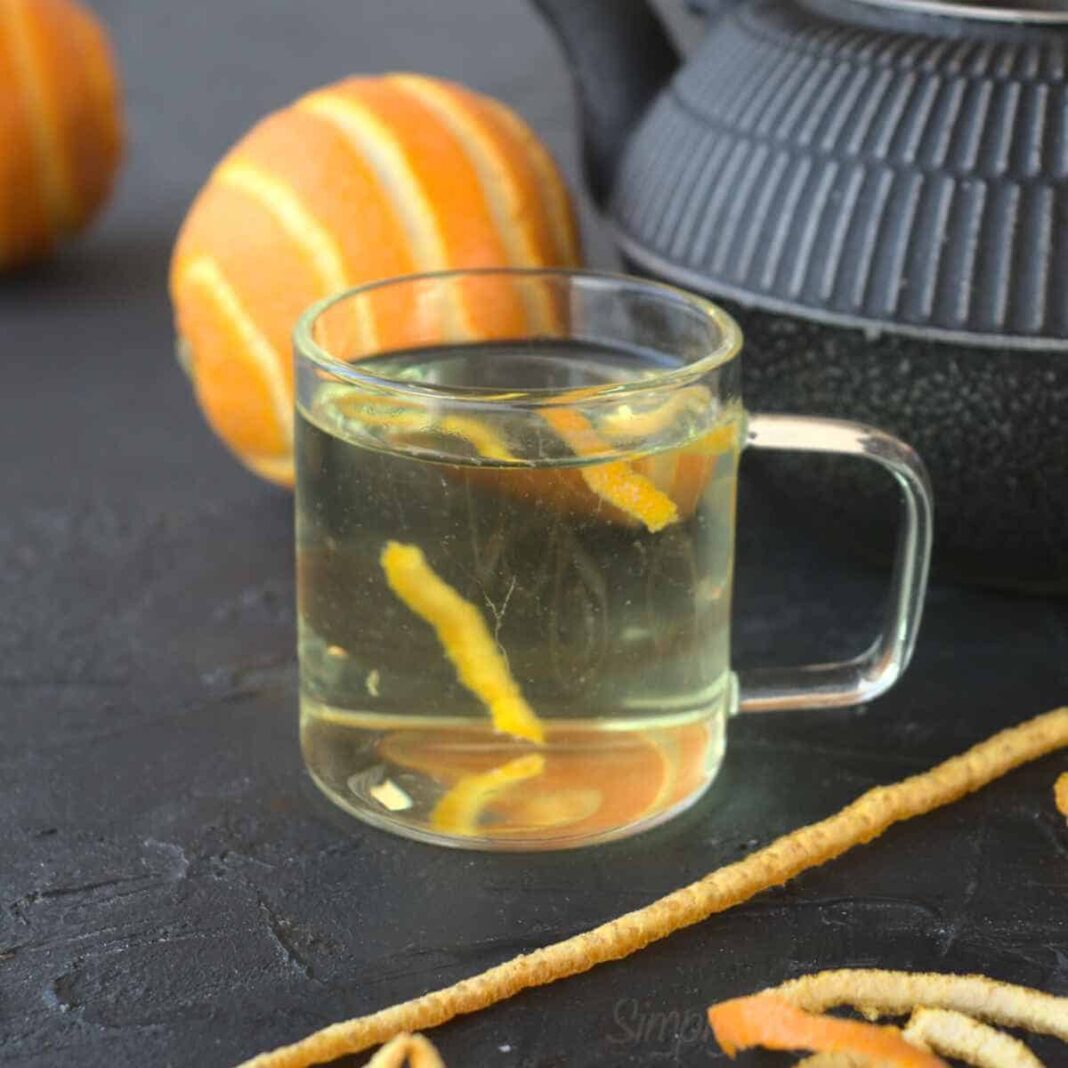This cool and refreshing colorful Orange Peel tea recipe will surprise you with its flavors, health benefits, and vitamin C content.
Don’t throw any orange peel away! Did you know you can make tasty tea using dried or fresh peel? It’s a great way to use up what would otherwise be considered waste.
While most people throw away citrus peels and eat orange fruits, I love to use them in various projects. Grinding them into a powder is a smart way to use citrus peel leftover. It is easy to store and use in baking, cooking or skin care.
What is orange peel tea?
Orange peel tea is made by steeping the dried or fresh peel of oranges in hot water. The tea has a distinct citrus flavor and aroma and is often used for health benefits. To make a flavorful, refreshing drink, use fresh or dried orange peels or a combination of both.
Health Benefits of Orange peel tea
Orange peel tea has gained popularity recently due to its high vitamin C content and ability to improve digestion.
Citrus peels have been used in traditional Chinese medicine for centuries for their warming effect on the body.
Reduce the risk of chronic diseases
Orange peel tea contains essential oils, flavonoids, and other compounds, giving it its characteristic aroma and flavor. These compounds have antioxidant, anti-inflammatory, and antimicrobial properties, which may help reduce the risk of chronic diseases such as heart disease, high blood pressure, cancer, and diabetes.
Support Immune System
Vitamin C is an essential nutrient that helps support the immune system, promote healthy skin, and reduce inflammation. Orange peels contain significant amounts of vitamin C, making them a great source of this vital nutrient. Drinking this tasty tea may help boost your vitamin C intake and support your overall health and well-being.
Lower level of cholesterol
Orange peel, albedo in particular, is one of the richest sources of pectin, used in preparing jams, jellies, and candied fruit. It has four times more pectin than the inner fruit. Pectin also eases and regulates intestinal function and blood sugar, thus keeping low bad cholesterol in the blood.
Improve Digestion
This homemade orange peel tea helps improve digestion by promoting the production of digestive enzymes and reducing inflammation in the gut. This can help alleviate symptoms such as bloating, constipation, and indigestion.
Similarly works grapefruit tea.
Moreover, making orange peel tea is a great way to use up leftover orange peels that would otherwise be discarded. By repurposing the peels into tea, you can reduce waste and make the most of the oranges you have on hand.
Why using Organic Oranges?
Before the drying process, wash the oranges with hot water to remove any pesticide residue.
This study shows that while the inner fruit of oranges has a very low level of pesticides, the peels contain a higher amount. For that reason, I always use oranges of organic quality, ideally locally produced.
With your fingers, a sharp knife or this orange peeler to peel them off. Cut the orange peel into small pieces to faster the drying process.
How to Dry Orange Peels?
Air drying
Air drying involves placing orange peel away from direct sunlight on a tray or rack. If you do this outdoors, covering the items with a cloth or netting is essential to protect them from insect and dust contamination. It took me four days for everything to be completely dry.
Using the oven
To speed up the drying of the peel, you can put it in the oven set to a low temperature. Be aware that ovens differ so it could take 1 to 2 hours at 35°C (95°F). It would be best to give the peel a shuffle every now and then to ensure it dries evenly. Leave the oven door slightly open to let out any excess moisture.
Using dehydrator
You can also use a food dehydrator.
Hint: To ensure the orange peel is dried completely, take a piece between your fingers and break it into two parts. If it is easy to break, it’s done. If it bends, continue the drying process.
Orange peel tea with splash of orange juice
Can I Drink Orange Peel Tea every day?
Yes, it is safe to drink it every day in moderation.
It’s important to note that excessive consumption of this delicious tea can cause gastrointestinal discomfort, including heartburn, acid reflux, and upset stomach. Therefore, it’s best to consume orange peel tea in moderation and not exceed 2-3 cups daily.
Additionally, suppose you have any underlying health conditions or are taking medications. In that case, it’s always a good idea to check with your healthcare provider before adding new foods or supplements, including orange peel tea.
Fresh orange peels or dried to make homemade orange peel tea?
You can use both fresh and dried orange peels, but they have slightly different flavors and aromas.
Fresh peels have a more intense and bright citrus flavor and aroma.
Dried orange peels have a more subtle, mellow flavor and aroma. They are also easier to work with because they are dry and can be stored for a longer.
ingredients to make orange peel tea
2-3 large organic oranges – use organic oranges that have not been treated with pesticides or other chemicals.
2 cups of filtered water – use a top-notch water filter. Tap water typically has scores of untested substances you wouldn’t want in your beverage.
Sweeteners (optional) – Add a drizzle of honey to the tea as a natural sweetener and add health benefits. You can also use maple syrup, stevia or brown sugar.
Splash of freshly squeezed orange juice
Orange peel tea recipe
Experiment with various methods to craft your own delicious tea! Whether using dried or fresh peels, simmering or steeping, and adding other flavors or not – find the recipe that best fits your palate.
I prefer to make boiled orange peels in a pot for 10-15 minutes.
First step – Gather orange peel.
if you are using fresh peel, wash the oranges with hot water to remove any pesticide residue that may be present. Use this orange peeler to peel them off. Cut the orange peel into small pieces. You can skip this step if you are using dried orange citrus peels.
Second step – Brew the tea.
Place the pieces in a pot or cattle, pour over the filtered water, and bring it to a boil. Turn off the heat and allow steeping for 10-15 minutes to keep as much as vitamin C. For more flavorful tea simmer for 5 minutes before turning off the heat.
Third step – Strain the peels.
Remove the tea strainer or infuser and discard the citrus peels.
Fourth step – add sweetener, and orange juice and serve.
Add sweeteners such as honey, sugar, or agave syrup to taste if desired. I like adding fresh orange juice to add extra citrusy flavor. Stir the tea, enjoy it!
You can serve it as hot tea or let it cool and serve it as orange iced tea.
Variations
The above recipe is just basic with two ingredients, opening many orange tea variations you can try.
Make it more flavorful by adding fresh or dried ginger root. I will give an extra kick of flavor and digestive benefits.
For a warm and cozy flavor simmer for 10 minutes the tea with a cinnamon stick or cinnamon powder.
Use regular black tea bags and add more flavors & spices to your orange-flavored tea.
Brew a cup of green tea and add fresh or dried orange peels to it to boost vitamin C and antioxidants.
Make a tea from orange and lemon peels to create a citrusy and refreshing tea combo.
Add fresh mint leaves to the orange tea for a refreshing and cooling flavor.
Make a tasty tea with chamomile flowers for a calming and soothing tea.
Freshly squeezed orange juice adds more orange flavor to your tea. Moreover, it is naturally sweet so you can skip the sweetener.
Other ways to Use Orange Peels
You can grate the orange peels to make orange powder. Alternatively, use orange zest in cakes, cookies, and cocktails.
Orange Extract gives rich flavor and aroma to any dessert or drink.
Turn in into Orange liqueur. Also known as Triple sec or Cointreau, the orange liqueur is made from orange peel and a neutral spirit and makes a great addition to your cocktails.
Homemade orange liqueur
Use as a Room Freshener.
Put the dried citrus peel into a sachet or place it in a bowl to freshen up a room.
Make Candied Orange Peels.
First, cut the peels into strips, boil them in orange syrup, and then coat them in sugar.
Use as a Natural Cleaner.
Orange peels have natural cleaning properties due to their high citric acid levels. Use it to clean surfaces, stovetops, and other kitchen appliances.
Repel Insects.
Orange peels contain a chemical called limonene, which is toxic to many insects. Rub orange peels on your skin or place them around your home to repel mosquitoes and other insects.
Make a Face Mask.
Use it to make a face mask. Grind the peels into a powder and mix with yogurt or honey to make a refreshing and exfoliating face mask.
How to store orange peel tea?
To store dried orange peel
To store orange tea in its dried form, make sure the orange peel is completely dry. as any moisture can cause the tea to spoil quickly.
Once the tea is dry, you can store it in an airtight container, such as a glass jar or a plastic container with a tight-fitting lid. It is best to store the tea in a cool, dry place away from direct sunlight, as exposure to heat and light can cause the tea to lose its color, flavor and aroma.
to store a brewed tea
If you have already brewed tea with orange peels and want to store it in liquid form, you should keep a few things in mind to ensure that it stays fresh and flavorful.
Firstly, ensure the tea has cooled to room temperature before storing it. This will help prevent bacterial growth and spoilage.
Once cooled, transfer the tea to a clean, airtight container and keep it refrigerated to prevent spoilage. The tea can be stored in the refrigerator for 3-4 days.
To serve the tea, pour it into a cup and reheat it on the stove or in the microwave.
To store the tea for even longer, transfer it to ice cube trays and freeze it.
How does orange tea taste?
Orange peel tea has a bright, citrusy flavor and aroma that can be both refreshing and invigorating. It’s a great alternative to traditional tea or coffee and can be enjoyed hot or cold.
Prep Time
5 minutes
Cook Time
10 minutes
Total Time
15 minutes
Ingredients
2 large organic oranges
2cups of filtered water
honey or sugar (optional) to sweeten
2 tablespoons orange juice
Instructions
If you are using fresh peel, wash the oranges with hot water to remove any pesticide residue that may be present. Use this orange peeler to peel them off. Cut the orange peel into small pieces. You can skip this step if you are using dried orange citrus peels.Place the pieces in a pot or cattle, pour over the filtered water, and bring it to a boil. Turn off the heat and allow steeping for 10-15 minutes to keep as much as vitamin C. For more flavorful tea simmer for 5 minutes before turning off the heat.Remove the tea strainer or infuser and discard the citrus peels.Add sweeteners such as honey, sugar, or agave syrup to taste if desired. Stir the tea, enjoy it hot, or let it cool and serve it as ice tea.
Notes
Serve warm or chilled. You can keep the strained tea refrigerated for up to 1 day.
Recommended Products
As an Amazon Associate and member of other affiliate programs, I earn from qualifying purchases.
Nutrition Information:
Yield: 2
Serving Size: 1
Amount Per Serving:
Calories: 174Total Fat: 0gSaturated Fat: 0gTrans Fat: 0gUnsaturated Fat: 0gCholesterol: 0mgSodium: 13mgCarbohydrates: 45gFiber: 6gSugar: 33gProtein: 3g
Did you make this recipe?
Please leave a comment on the blog or share a photo on Instagram


